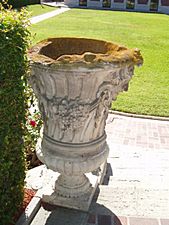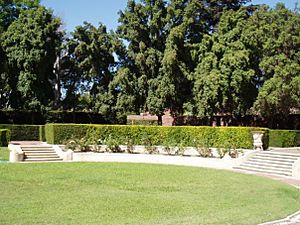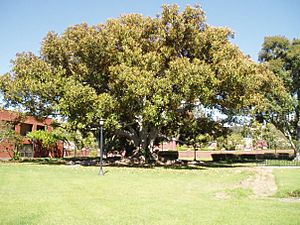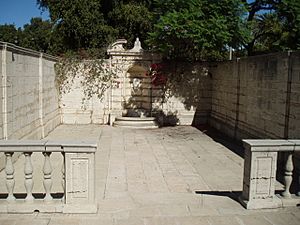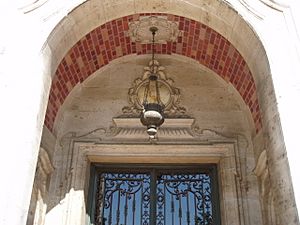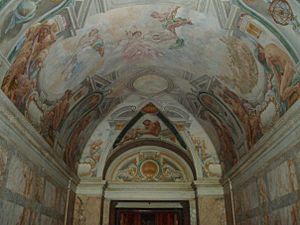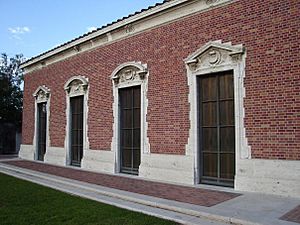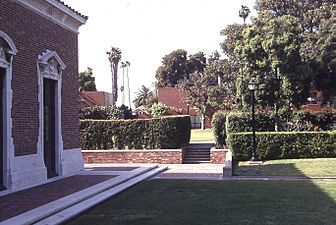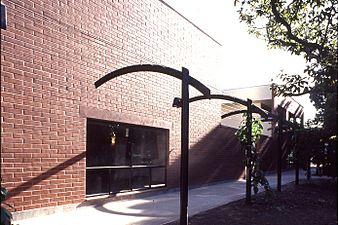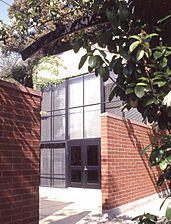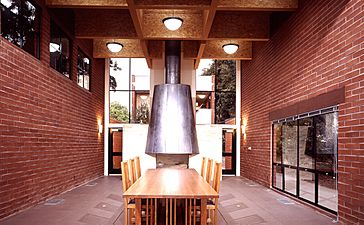William Andrews Clark Memorial Library facts for kids
Quick facts for kids William Andrews Clark Memorial Library |
|
|---|---|
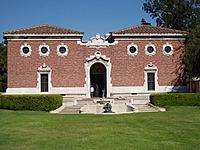 |
|
| Established | 1924 |
| Location | 2520 Cimarron St, Los Angeles, California 90018 |
| Coordinates | 34°01′59″N 118°18′51″W / 34.03303°N 118.31426°W |
| Branches | N/A |
| Collection | |
| Size | 110,000 (rare books); 22,000 (rare manuscripts) (2007) |
| Access and use | |
| Circulation | Library does not circulate |
| Other information | |
| Budget | US$30 million (total endowment) |
| Director | Helen Deutsch |
| Staff | 6 (FTE) |
The William Andrews Clark Memorial Library (also called the Clark Library) is a special library linked with the University of California, Los Angeles (UCLA). It holds many rare books and old handwritten papers. The library is especially strong in English literature and history from 1641 to 1800. It also has a huge collection about writer Oscar Wilde and beautiful, special edition books.
The library is about ten miles southeast of UCLA. It is in the West Adams area of Los Angeles. The library is managed by UCLA's Center for Seventeenth- and Eighteenth-Century Studies. This center offers special study programs for students and researchers. Anyone interested in the collections is welcome to visit and study there.
Contents
History of the Clark Library

The Clark Library and its collections were created by William Andrews Clark, Jr.. He named it after his father, U.S. Senator William Andrews Clark, Sr.. His father made a lot of money from copper mining in states like Montana, Arizona, and Nevada.
Clark Jr. was a famous book collector and a kind person who gave money to good causes. He used to have a house on the same property where the library now stands. That house was taken down in the 1970s. The current library building was designed by architect Robert D. Farquhar. It was built between 1924 and 1926.
After the library was finished, Clark Jr. decided to give his entire collection to the Southern Branch of the University of California (which later became UCLA). At that time, he had about 13,000 books. When he passed away in 1934, the library, its buildings, and the whole block of land were given to UCLA. He also gave $1.5 million to help run it. This was UCLA's first very large gift and one of the biggest in its history.
In 1985, the Clark Library's management moved to the Center for 17th and 18th Century Studies. This group at UCLA's College of Humanities plans events and programs about old books and history. The library is also used for meetings, talks, and music concerts.
Amazing Collections
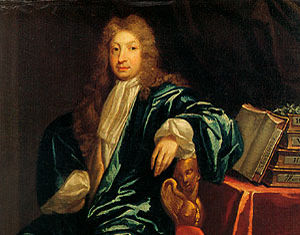
The early 1900s were a great time for collecting books in America. William Andrews Clark, Jr. was one of many wealthy people who loved collecting books. Others included J. Paul Getty and Henry E. Huntington.
At first, Clark collected many different English books. His library had important editions of works by Shakespeare, Chaucer, and Dickens. He also collected French literature and handwritten letters from famous people. He even had items about exploring the American West.
Over time, Clark started to focus on English literature from the 17th and 18th centuries. This period is called the English Restoration. These collections are now the strongest part of the Clark Library. He also gathered a very large collection of books and papers by Oscar Wilde.
Clark was also interested in beautiful printing from the Arts and Crafts movement. The library has full sets of books printed by the Kelmscott Press and Doves Press. These two presses greatly influenced how books were printed in England around 1900. The library also has many books from American Arts and Crafts printers, especially those from California. It also holds the library and papers of printer Eric Gill. The library still collects items in this area today.
In 2009, a nuclear physicist named Paul Chrzanowski gave 72 Shakespeare books to the Clark Library. These books were printed between 1479 and 1731.
As of 2006, the library has over 110,000 rare books and 22,000 handwritten papers. It also has many modern books, magazines, and microfilms for research.
17th and 18th Century Treasures
The Clark Library has one of the largest collections of British literature and history. This covers the period from the English Civil War to the time of King George II (1641–1761). Many of its collections are almost as big as those at the British Library.
The literary collections include works by famous writers like John Dryden, John Milton, Daniel Defoe, and Aphra Behn. The library also has many music books and songs printed before 1750. This includes operas, and the works of composers like Purcell and Handel.
Some of its most valuable collections are scientific works by Isaac Newton, Robert Boyle, and Edmond Halley. The library also holds important religious and philosophical writings. These include works by Thomas Hobbes and John Locke.
Oscar Wilde Collection
Perhaps the most special and largest collection at the library is about Oscar Wilde. It is thought to be the most complete collection of his work in the world. Clark originally bought Wilde's handwritten papers from Wilde's son, Vyvyan Holland.
Today, the collection includes photos, original drawings, funny pictures, play posters, and newspaper clippings. Most important studies about Wilde in recent years have used the Clark's materials. The Clark also collects books and papers from Wilde's friends and other artists from the 1890s. This includes important editions of works by William Butler Yeats.
Special Study Programs
The Clark Library offers several special study programs, called fellowships. These are for graduate students and scholars who have already finished their main studies. These programs allow them to study at the Clark Library.
Some of the most well-known fellowships include the Ahmanson-Getty Fellowship and the Clark Dissertation Fellowship. All these programs are managed by UCLA's Center for Seventeenth- and Eighteenth-Century Studies. Each fellowship offers different amounts of money and lasts for different lengths of time. All of them require the person to use the Clark Library's collections for their research.
Library Architecture
The library is located on a block surrounded by a wall in the West Adams neighborhood. It is a beautiful two-story building designed like a grand garden house. The architect, Robert D. Farquhar, was famous in California. The building's two main reading rooms look like the Villa Lante in Italy.
The library's brick and stone outside walls are in an English baroque style. This is similar to the style used by Christopher Wren at Hampton Court Palace. The brickwork is very detailed, with five different colors and lavender-colored mortar.
The library stands on what used to be the yard of a large house built in the early 1900s. The property was unusual because it was surrounded by a brick wall. Clark liked this feature. After he bought the property, he bought and removed eleven nearby houses. He then extended the wall around the entire block. He also hired a landscape architect, Ralph D. Cornell, to plan a public park. This park was never finished.
When Clark gave the library to UCLA in 1934, he said that no new building could ever be built within one hundred feet of the library. For sixty years, the building stood in an unfinished landscape. The old house and an observatory were removed over time.
In 1988, an architecture firm called Barton Phelps & Associates was asked to create a new plan for the site. Because of Clark's rules, they suggested building a large research area around a garden that would be below ground level. Money for this project came from the Getty and Ahmanson Trusts.
The first part of the building project created new facilities for the library. This part is a long, two-story building that looks like a wall. It has four sections separated by courtyards. This part is called a "range," a term from the 18th century. The North Range is 270 feet long and runs along the north side of the block. It holds offices, meeting rooms, food services, and guest rooms. It leaves the center of the site open. Its design and color match the red brick fence more than the library itself.





